Örnsköldsvik
| Örnsköldsvik | |
|---|---|
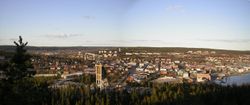 |
|
| Nickname(s): Ö-vik, Foppaland | |
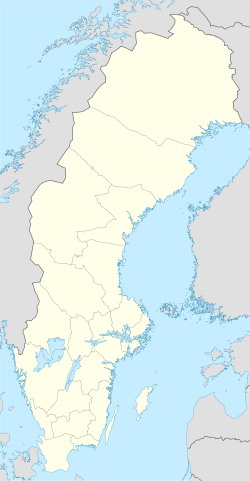 Örnsköldsvik
|
|
| Coordinates: | |
| Country | Sweden |
| Province | Ångermanland |
| County | Västernorrland County |
| Municipality | Örnsköldsvik Municipality |
| Area[1] | |
| - Total | 23.97 km2 (9.3 sq mi) |
| Population (2005-12-31)[1] | |
| - Total | 28,617 |
| - Density | 1,194/km2 (3,092.4/sq mi) |
| Time zone | CET (UTC+1) |
| - Summer (DST) | CEST (UTC+2) |
Örnsköldsvik (IPA: [œrnʂœldsviːk]) is a locality and the seat of Örnsköldsvik Municipality in Västernorrland County, Sweden with 28,617 inhabitants in 2005.[1]
Its natural harbour and archipelago is in the Gulf of Bothnia and the northern boundaries of the High Coast area of outstanding natural beauty. It is well known as an exporter of paper products and heavy machinery goods. It has a strong environment record and is the "testbed" for ethanol powered cars.
Contents |
History
The name comes from Governor Per Abraham Örnsköld (1762-1769) and literally translated means Eagle-shield's-bay (Örn-skölds-vik).
Traces of human activity in the area date back to the Nordic Bronze Age, and there's a reconstructed iron age village called Gene fornby, which is a popular tourist attraction, just outside of town. Örnsköldsvik itself is however a relatively young city, it was founded as a market town (a köping) in 1842 and became a city in 1894. As a city, the most important business was trade and heavy industry. In the surrounding villages (now incorporated parts of the city itself) two major industrial ventures raised: Modo as a pulp, paper, lodging combinate and Hägglunds as a heavy industrial company.
Örnsköldsviks Municipality
The town of Örnsköldsvik is the centre of Örnsköldsviks Kommun or Örnsköldsvik Municipality. The Municipality has a much larger population than the town itself, at over 55,000 inhabitants, as the municipality is vast with very large forest areas, and consists of several rural communities in the countryside.
Economy
Even today the ancestors of these two companies are of huge importance for the city. M-real (ex-Modo) is running one of Europe's largest pulp mills in the village of Husum, 30 km north of Örnsköldsvik City, while Hägglunds is split into several companies, including BAE Systems Hägglunds, now a subsidiary of BAE Systems. Other notable companies based in Örnsköldsvik include Svensk Etanolkemi, a producer of ethanol products, and Fjällräven, a manufacturer of outdoor equipment and clothing.
Education
In Örnsköldsvik there are at present local branches of two universities, Mid Sweden University and Umeå University.
Transportation
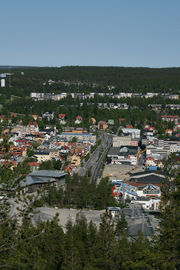
Main road transportation is provided by the European route E4. The Örnsköldsvik Airport provides daily flights to and from the Stockholm-Arlanda Airport courtesy of Höga Kusten Flyg, and also charter flights to Turkey courtesy of Pegasus Airlines. During a short period in early 2008, Skyways airlines also provided flights from Örnsköldsvik to Stockholm-Arlanda Airport, however, introducing the connection just as Höga Kusten Flyg started up, it soon ceased its flights and currently code-share with Höga Kusten Flyg to Örnsköldsvik.
The terminal building was recently upgraded to allow for international services, such as the charter service to Turkey. The runway was also extended to allow service for larger aircraft, also to accommodate charter flights, but also because Scandinavian Airlines was forced to fly their Boeing 737 jets with reduced passenger capacity during winter conditions.
Railway transportation will in the future be provided by the new main line Botniabanan, which is currently under construction. Currently Örnsköldsvik is only connected to the main railway system via a branch rail line connecting it to Stambanan genom övre Norrland at Mellansel, roughly 25 km west of Örnsköldsvik.
Botniabanan will connect Örnsköldsvik and nearby Umeå with passenger services to Stockholm in around 4 hours of travel time, challenging the airlines that combat additional travel time in to/from trips as well as extensive security scannings.
There is also a harbor, where cargo ships load and unload timber and other merchandise. Prior to joining the European Union, Örnsköldsvik had a direct ferry connection to Vaasa, Finland. This ceased operation after the entry in to the European Union along with the abolishment of tax-free trade within the member states.
The harbor now rarely sees passenger traffic on any larger scale, despite being one of the deepest natural harbors in Europe, along with Köpmanholmen harbor, located 20 km south of Örnsköldsvik.
Being situated on the European route E4, the city is well connected with bus lines. A coastal line from Haparanda in the north to Stockholm makes regular stops at the bus depot in Örnsköldsvik. A cross-country route to Östersund is starts and terminates at the Örnsköldsviks bus depot.
Recreation and sports
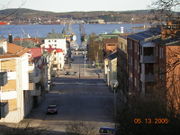
Due to the hilly surroundings, hiking and exploring the scenery of the High Coast is popular in the area. In the wintertime skiing and ice hockey are both popular. Both cross-country skiing, alpine skiing and also ski jumping are practiced in the downtown area. In international sports, the town is perhaps best known for having hosted the inaugural Winter Paralympic Games, in 1976.
Since Örnsköldsvik is a coastal town, there are also beaches near town, as well as campsites. There's also an indoor water park called Paradisbadet, with one of the longest water slides in Europe.
The 2008 European Curling Championships took place in the town. The two groups, A and B, played in the Swedbank and Skyttishallen arenas respectively.
Sports is also popular, the main spectator sport in town is ice hockey, with the local team Modo Hockey in Elitserien, the main league for ice hockey in Sweden. The local football teams aren't quite as successful, but still popular. On the men's side especially the teams Friska Viljor FC from central Örnsköldsvik and Anundsjö IF from Bredbyn outside of town, and women's Själevads IK. A couple floorball teams from town have also had some success.
A new golf course, Veckefjärdens Golf Club, to the south of the centre is owned by local celebrity ice hockey star Peter Forsberg - nicknamed Foppa. This has resulted in Örnsköldsvik being given the nickname "Foppaland" in Swedish popular culture.
The islands surrounding the coastal area of Örnsköldsvik are big tourist attractions which can be reached by ferry boats.
Notable natives
Örnsköldsvik is the birthplace of many world-famous ice hockey players, including Peter Forsberg, Markus Näslund, Niklas Sundström, Victor Hedman and the twins Daniel and Henrik Sedin. The Sedin twins are currently top players for the Vancouver Canucks. Samuel Påhlsson, also an ice hockey player, lived there for a long time but was born in Ånge. Many stars from hockey's previous generation, including Anders Hedberg, Thomas Gradin, and Anders Kallur were also either Örnsköldsvik natives (Hedberg) and/or played in the town for the Modo Hockey club.
Malin Moström, captain and key player in the Sweden women's national football team is also a native of Örnsköldsvik.
Magdalena Forsberg, cross country skier and biathlete.
Hans Hedberg, sculptor known for his gigantic ceramic fruit.
Märta Nordberg, outstanding cross country skier in the end of the 1940s and beginning of 1950s.
Tomas Haake and Mårten Hagström, members of (drummer and rhythm guitarist) Swedish technical metal band Meshuggah.
Thomas Hammarberg, diplomat and human rights activist.
Niklas Edin, skip (curling) of the Swedish curling team at the 2010 Winter Olympics in Vancouver.
International relations
Twin towns — Sister cities
Örnsköldsvik is twinned with:
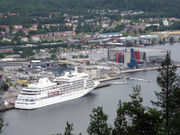
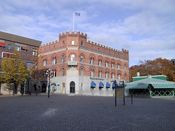
Örnsköldsvik's sister cities are:
Trivia
- The asteroid 6795 Örnsköldsvik, found in 1993 by Swedish astronomers at the European Southern Observatory, was named after the city.
- The name Örnsköldsvik is sometimes unofficially translated into English as Eagle Shield's Bay.
See also
- Modo Hockey
- 1976 Winter Paralympics
References
- ↑ 1.0 1.1 1.2 "Tätorternas landareal, folkmängd och invånare per km2 2000 och 2005" (in Swedish) (xls). Statistics Sweden. http://www.scb.se/statistik/MI/MI0810/2005A01B/T%c3%a4torternami0810tab1.xls. Retrieved 2009-05-09.
External links
- Örnsköldsvik - Official site
- (English) Örnsköldsvik Tourist Information
- (Swedish) Mid-Sweden University College at Örnsköldsvik
- (English) Campus Örnsköldsvik at Umeå University
- (English) Örnsköldsvik Airport
- (Swedish) article Örnsköldsvik from Nordisk Familjebok (1922).
| Örnsköldsvik is one of 133 places with the historical city status in Sweden. |
|
|||||
|
|||||
|
||||||||||||||